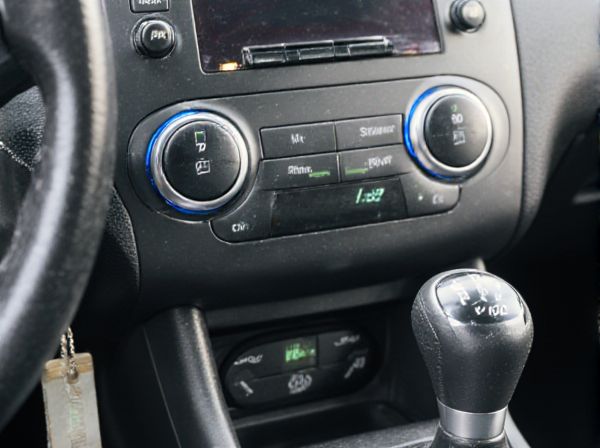
Photo illustration: Kickdown vs Downshift
Kickdown occurs when you fully depress the gas pedal, causing the transmission to downshift quickly for maximum acceleration. Downshift refers to manually or automatically shifting to a lower gear to increase engine power or control speed, especially on hills or during overtaking. Both techniques enhance your vehicle's responsiveness but differ in trigger method and purpose.
Table of Comparison
| Feature | Kickdown | Downshift |
|---|---|---|
| Definition | Automatic transmission forced to lower gear by full throttle | Manual or automatic shift to a lower gear for engine braking or acceleration |
| Activation | Triggered by pressing accelerator pedal fully | Triggered by driver manually shifting or automatic system detecting need |
| Purpose | Instant power boost for acceleration | Control speed, enhance engine braking, or gain torque |
| Transmission type | Primarily automatic transmissions | Manual and automatic transmissions |
| Effect on fuel efficiency | Higher fuel consumption during activation | Can improve efficiency by matching engine speed to load |
| Driver control | Limited manual control | Full manual control or automatic intervention |
| Common use case | Overtaking, rapid acceleration | Descending hills, preparing for turns |
Introduction to Kickdown and Downshift
Kickdown is a feature in automatic transmissions that quickly downshifts to provide maximum acceleration when the accelerator pedal is fully pressed. Downshift refers to manually shifting the transmission to a lower gear to increase engine power and control, commonly used in both automatic and manual vehicles. Understanding the distinction between kickdown's automatic responsiveness and downshift's manual control is essential for optimizing driving performance and fuel efficiency.
Understanding Kickdown in Automatic Transmissions
Kickdown in automatic transmissions triggers a rapid downshift when the accelerator pedal is pressed beyond a certain point, providing extra power for acceleration or overtaking. This mechanism enhances engine responsiveness by temporarily increasing RPMs, allowing the vehicle to utilize lower gears effectively. Unlike manual downshifting, kickdown operates automatically, optimizing driving performance without driver intervention.
What is Downshifting in Manual and Automatic Cars?
Downshifting in manual cars involves manually shifting to a lower gear to increase engine RPM and enhance acceleration or engine braking. In automatic cars, downshifting occurs when the transmission shifts to a lower gear, either automatically or via driver input, to provide more power or control. Kickdown is a specific automatic transmission response triggered by fully pressing the accelerator pedal, forcing a rapid downshift for maximum acceleration.
Key Differences Between Kickdown and Downshift
Kickdown and downshift both involve changing gears to increase engine power, but kickdown is an automatic transmission feature that forces a quick downshift when the accelerator is fully pressed for rapid acceleration. Downshift typically refers to manually shifting to a lower gear in a manual or automatic transmission to enhance engine braking or power delivery. The key difference lies in kickdown being an automatic response to full throttle, while downshift is often a deliberate driver-initiated gear change.
How Kickdown Works: Step-by-Step
Kickdown activates when the accelerator pedal is quickly pressed to the floor, signaling the transmission to downshift for immediate power. This process electronically or hydraulically commands the transmission to shift to a lower gear, increasing engine RPM and torque output. The result delivers rapid acceleration, especially helpful during overtaking or climbing steep inclines.
Downshifting Techniques for Optimal Performance
Downshifting techniques for optimal performance involve smoothly engaging the clutch while simultaneously matching engine speed to wheel speed, a process known as rev-matching. Proper downshifting improves vehicle control, especially during cornering or deceleration, by preventing drivetrain shock and maintaining engine responsiveness. Mastery of heel-toe downshifting enhances acceleration and stability, crucial for performance driving and reducing wear on transmission components.
When Should You Use Kickdown?
Kickdown should be used when rapid acceleration is needed, such as merging onto highways or overtaking slower vehicles, as it downshifts the transmission to a lower gear to maximize engine power. This technique provides an immediate boost in torque and responsiveness, ensuring smoother and quicker acceleration without manual gear changes. Using kickdown conserves engine efficiency by only engaging lower gears momentarily, preventing unnecessary fuel consumption during short bursts of speed.
Situations Where Downshifting is Preferred
Downshifting is preferred in situations requiring precise control over vehicle speed, such as navigating steep descents or preparing to accelerate out of a tight corner. When engine braking is necessary to maintain stability and reduce brake wear, downshifting offers smoother deceleration compared to kickdown. In heavy traffic or adverse weather conditions, downshifting enhances traction and control by allowing the driver to modulate power delivery more effectively.
Pros and Cons: Kickdown vs Downshift
Kickdown delivers rapid acceleration by fully opening the throttle and forcing a lower gear, enhancing responsiveness during overtaking or steep inclines but potentially increasing fuel consumption and transmission wear. Downshifting gives drivers precise control over gear selection, improving engine braking and performance in challenging driving conditions, yet it requires skill to avoid excessive engine revs and clutch wear in manual transmissions. Choosing between kickdown and downshift depends on driving style, with kickdown favoring convenience and quick power delivery, while downshifting supports efficiency and control.
Conclusion: Choosing the Right Technique
Kickdown delivers rapid acceleration by automatically downshifting to a lower gear when the throttle is fully pressed, ideal for quick overtaking or merging. Manual downshifting grants the driver greater control over gear selection, enhancing performance and engine braking on demanding terrains or spirited driving. Selecting the right technique depends on the driving scenario and personal preference for control versus convenience, with kickdown suited for immediate power needs and downshifting preferred for precision and engagement.
 caratoz.com
caratoz.com